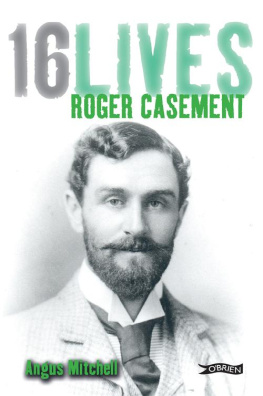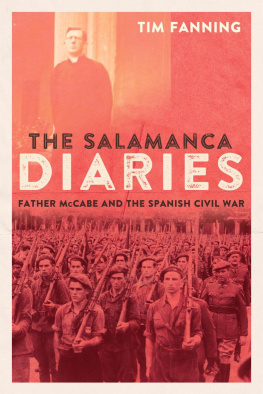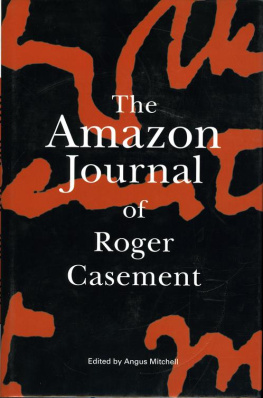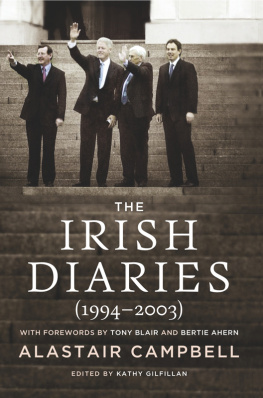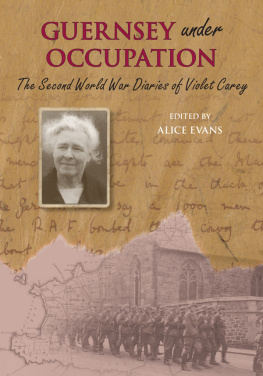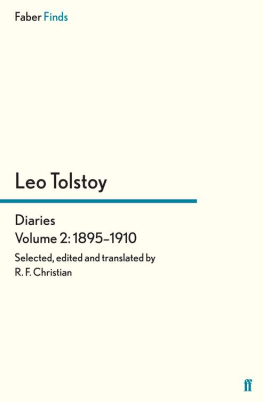Acknowledgements

My first duty is to thank Elspeth Parry who, on behalf of the Parry family, gave permission for the diaries to be published. The Parrys, as residuary legatees of Mrs Sidney Parry (ne Gertrude Bannister) are owners of the copyright in Roger Casements writings.
Others must also be thanked for providing access to archives and facilitating publication of the papers in their care. Foremost among the repositories used are the Public Record Office in Dublin. Thanks are expressed to Anne Crawford, Bruno Derrick and Nick Forbes of the PRO, and to the Deputy Keeper of Manuscripts, Gerard Lyne, and the Council of Trustees of the NLI. Robert Kee kindly allowed me to use transcripts of his interview with the leading Counsel defending Casement at his trial, A. M. Sullivan, Second Serjeant of the Irish Bar.
Much help was also received from Dr Peter B. Boyden, of the National Army Museum, Andrew Brown, of the Metropolitan Police Archives Branch, Paul Buxton and Dr Charles Swaisland, of Anti-Slavery International, Nicholas S. Carlyle, of the Home Office Library, Andrew Davidson, of the Foreign and Commonwealth Library, Amanda Hill, archivist at Rhodes House Library, Oxford, Christopher Maitland, of the Royal Belfast Academical Institution, Dr S. G. Roberts, of the Royal Commission on Historical Manuscripts, Dr Samas Sochin, of St Patricks College, Maynooth, and Katharine Thomson, Modern Manuscripts Assistant at Balliol College, Oxford. Their assistance is greatly appreciated.
Occasionally, Casements eccentric use of Spanish and Portuguese made it necessary for me to consult linguists, and my problems were solved by Arancha Hernando, Helen McCurdy and Alberto and Jenny Penalva. Similar confusing references, mainly geographical, were explained by Carmen Azurin, of the Peruvian Embassy (London), and by Anita Nueman, of the Swedish Embassy (London).
Librarians generally proved that the most obscure publications could be located, given determination and know-how. Those of my own village library Rosemary Bell and Alison Healy were second to none. And Joy Caisley and Nicholas Graffy, of Southampton University, never failed to deliver. Alan Phillips, of the British Humanities Index was a constant source of useful information, as was Lieutenant Commander David Webb RN.
Others whose advice is highly valued are best listed in alphabetical order: John Anthony, Monica Ayles, Frank Cakebread, Pamela Freeman, B. M. Hewitt, the Lord Howard de Walden, George Mansur, Stuart Monard, Kurt E. Schmid, Robert Shanks, Richard Usborne, and Bill and Elizabeth Wall.
It was a privilege to be able at all times to rely on a member of the Casement family for inside knowledge. Hugh Casement was a volunteer, and his assistance was greatly welcomed. Subsequently, by what seemed to be an extraordinary and happy coincidence, it transpired that Colonel Patrick Montgomery, retired Secretary of the Anti-Slavery Society and my mentor and main supporter for everything I have written, is godfather to Hugh Casements brother, Robert. My chief debt of gratitude is to Pat and his wife Moskie, who know best how to sustain a friend, especially when the going is not smooth.
Finally, I must express my appreciation for all the encouragement I have received from Will Sulkin, publishing director of Pimlico, who commissioned this book.
Hereafter referred to as the PRO.
PIMLICO
ROGER CASEMENTS DIARIES
In 1864, Roger Casement was born into the Irish landed gentry, the fourth and last child of a Protestant father and a Roman Catholic mother. By the age of 13 he was an orphan, boarding at a school which later became Ballymena Academy, and spending his holidays mainly at the family seat, Magherintemple, or with the Bannisters his maternal aunts family in Liverpool.
On leaving school Casement started working for the Elder Dempster Shipping Company, and in 1883 became purser on board one of the companys ships trading with West Africa. This led to a number of adventurous African posts, initially in the Congo Free State.
Casements primary career began with his employment by the Foreign Office in what is now Nigeria. His performance there led to his joining the British consular service, and a succession of African appointments followed. After an interlude of special service during the Boer War, his last African post as consul was in the Congo. There he became famous as an emancipator, in the cause of the rubber-gathering slaves. The British government published Casements Congo Report in 1904, a year which also saw a crucial stage in the development of his commitment to the cause of Irish separatism. Six years later he investigated allegations of enslavement of rubber-gathering natives in South America. By this time, after consular postings in Santos and Par, he had become Consul-General in Rio. His report was published as a Blue Book in 1912. Casement was knighted in 1911.
Retirement from the consular service meant that undivided attention could now be given to Ireland. After the outbreak of war in 1914 Casement went to Germany, where he tried to recruit Irish prisoners-of-war for a brigade to support a nationalist rebellion. His mission failed; Casement was returned to Ireland in a German U-boat, captured, taken to London, and sentenced to death and hanged for high treason.
During and after Casements trial the so-called Black Diaries a collection of documents containing some descriptions of his homosexual activities were shown to people in power who would otherwise have supported petitions for a reprieve. After Casement was hanged on 3 August 1916, efforts continued to be made by his enemies to use the diaries in order to poison his reputation in Ireland and America.
Roger Sawyer was educated at Wycliffe College, the University of Wales, and the University of Southampton. He was awarded the T. G. James Prize in Education and subsequently embarked on a school-mastering career. After a housemastership at The Blue Coat School, Edgbaston, he became Deputy Head, then Headmaster, of Bembridge Preparatory School. He presented his doctoral thesis entitled Origins and career of Roger Casement with particular reference to the development of his interest in the rights of dependent ethnic groups in 1979. He took early retirement in 1983 and has since concentrated on writing. His books include Casement: The Flawed Hero (1984), Slavery in the Twentieth Century (1986), Children Enslaved (1988) and We are but Women: Women in Irelands History (1993).
In 1985 he received the Airey Neave Award for Research into Freedom under National Laws. He is a member of the Council of Anti-Slavery International.
Contents

This eBook is copyright material and must not be copied, reproduced, transferred, distributed, leased, licensed or publicly performed or used in any way except as specifically permitted in writing by the publishers, as allowed under the terms and conditions under which it was purchased or as strictly permitted by applicable copyright law. Any unauthorised distribution or use of this text may be a direct infringement of the authors and publishers rights and those responsible may be liable in law accordingly.
Version 1.0
Epub ISBN 9781446413333
www.randomhouse.co.uk
PIMLICO
An imprint of Random House
20 Vauxhall Bridge Road, London SW1V 2SA
Random House Australia (Pty) Ltd
20 Alfred Street, Milsons Point, Sydney
New South Wales 2061, Australia
Random House New Zealand Ltd
18 Poland Road, Glenfield
Auckland 10, New Zealand
Random House South Africa (Pty) Ltd
Endulini, 5A Jubilee Road, Parktown 2193, South Africa


